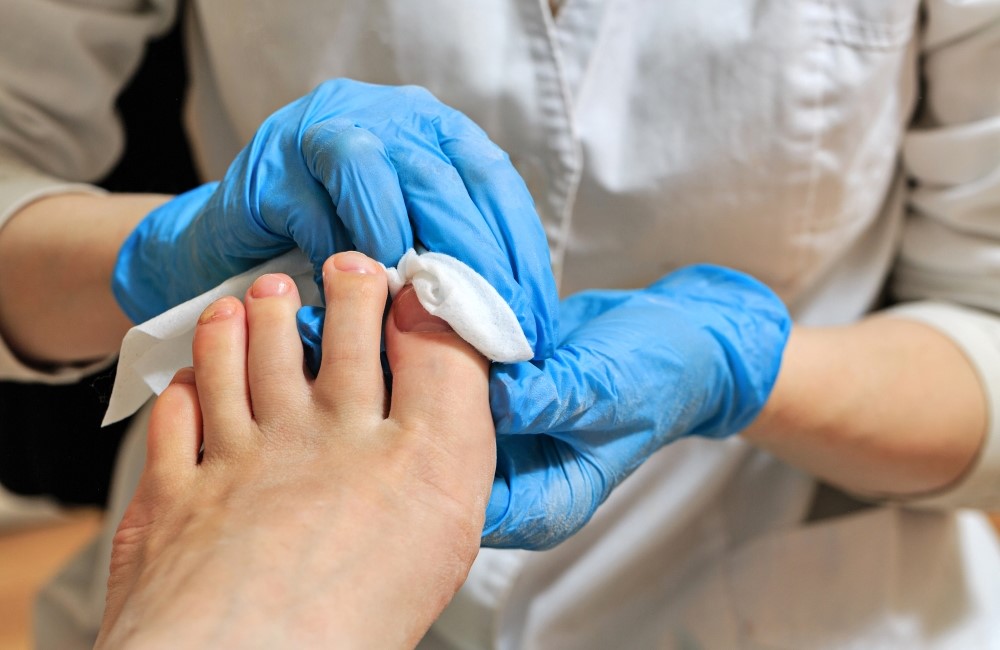What exactly is a
diabetic foot?
The term “diabetic foot” or “diabetic foot disease” refers to a clinical picture that occurs in connection with diabetes mellitus. It is a complication that can occur in cases of long-term poorly controlled or untreated diabetes.
The nerve and circulatory damage results in a reduced sensation of pain. Unnoticed injuries and pressure points can lead to serious infections or even amputation as a result of impaired wound healing. Prevention through blood glucose control, foot care, appropriate footwear and early treatment are therefore crucial.
About the symptoms
More information
Important information about the diabetic foot
Symptoms and consequences of diabetic foot:
- Decreased sensation of pain
- Numbness or tingling sensation
- Dry skin
- Change the shape of the foot
- Ulcers and open wounds
- Infections
- Tissue necrosis (gangrene), dead tissue in advanced and untreated infection.
- Impairment of mobility and thus also impairment of the quality of life
- Amputation of the affected toes, parts of the foot, or even the whole (in severe cases).
What are the manifestations of diabetic foot?
A diabetic foot can have various causes, according to which the symptoms can also differ. In many cases, however, there is a combination of both manifestations.
Neuropathic diabetic foot: due to diabetes-related nerve damage. The skin nerves are impaired here, leading to loss of sensitivity, malpositioning of the foot and increased callus at pressure points. The skin is warm and rosy.
Ischemic diabetic foot: due to circulatory disorders. Blood flow is decreased, the skin is pale or bluish, feels cool, and the pulse of the foot arteries is no longer palpable. Cramp-like pain, especially when walking, may occur.
How severe can diabetic foot get?
There are different stages in the clinical picture of diabetic foot, which describe the severity of the disease and the extent of the damage to the foot. People can already be considered patients if they do not yet have any obvious foot lesions, but the risk of developing diabetic foot syndrome is increased due to their own medical history (stage 0).
The focus here is on preventing the following stages:
Stage 1: Neuropathy
Stage 1: Neuropathy
Sensitivity disorders, numbness or tingling in the feet
Stage 2: Neuropathic ulcer
Stage 2: Neuropathic ulcer
Open wounds or ulcers, extending to the tendon or capsule
Stage 3: Ischemia
Stage 3: Ischemia
Impaired circulation (ischemic diabetic foot), pale or bluish skin, impaired wound healing, possibly ulcers or dead tissue (gangrene)
Stage 4: Infection
Stage 4: Infection
Infected and open wounds, infection can spread to surrounding tissue or even to the bones (osteomyelitis), risk of sepsis
Stage 5: Gangrene and threat of amputation
Stage 5: Gangrene and threat of amputation
Stopping the spread of infection and saving the patient's life
How is a diabetic foot diagnosed?
Early diagnosis and a comprehensive examination are critical to preventing complications of diabetic foot. Regular examination of the feet and immediate consultation with a physician if problems are suspected are important to initiate appropriate treatment and maintain foot health.
Diagnosis of diabetic foot is usually made by a combination of different measures. This often involves a multidisciplinary team consisting of diabetologists, podiatrists, wound experts and other specialists in the diagnosis and treatment.
Medical history and clinical examination
Obtaining the patient's medical history, a thorough clinical foot examination for skin lesions, ulcers, infections, deformities, and nerve function, and sensitivity tests such as the monofilament test to check the sensitivity of the soles of the feet.
Circulation examination
Measurement of foot pulse or Doppler ultrasound examinations to detect possible circulatory disorders.
Laboratory tests and imaging
Blood tests to assess long-term blood glucose levels (HbA1c) and diabetes control, testing of inflammatory markers and infection parameters, and X-rays, magnetic resonance imaging (MRI), or computed tomography (CT) scans if bone changes or infections are suspected.
Obtaining the patient's medical history, a thorough clinical foot examination for skin lesions, ulcers, infections, deformities, and nerve function, and sensitivity tests such as the monofilament test to check the sensitivity of the soles of the feet.
Measurement of foot pulse or Doppler ultrasound examinations to detect possible circulatory disorders.
Blood tests to assess long-term blood glucose levels (HbA1c) and diabetes control, testing of inflammatory markers and infection parameters, and X-rays, magnetic resonance imaging (MRI), or computed tomography (CT) scans if bone changes or infections are suspected.
Sources
Please note that all content provided regarding individual medical conditions, treatments, procedures, etc. is general information and may vary depending on the physician:in and individual case and initial situation.
For more detailed information, please always consult your doctor.
National health care guideline: Therapy of type 2 diabetes (S3, under revision).
www.leitlinien.deMorbach S, Lobmann R, Eckhard M, Müller E, Reike H, Risse A et al. Diabetic Foot Syndrome. Diabetologist 2020; 16(1): 54-64.
pubmed.ncbi.nlm.nih.govDiabetes Information Service Munich: Consequential diseases feet
www.diabinfo.deHerold G.: Internal Medicine. Self-published. 2014.
www.herold-innere-medizin.de